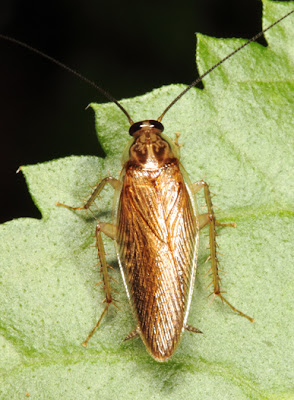A native blattodean, Carbrunneria cerciflavida (Roth), a species that has probably never been photographed before.
Another native blattodean, Beybienkoa kurandanensis Roth.
Another native blattodean, Carbrunneria marci (Roth). The markings on the thorax are species-distinctive in this group of blattodeans.
A bark-dwelling cricket, Myara sp., has taken up residence in a planted, introduced pine tree, Pinus.

This agraeciine katydid, Goodangarkia prasinus (Karny) is "mouthing" the exudates on the rim of a Pitcher Plant. The exudates lure potential prey into the pitcher where they fall into the digestive juice of the plant.
Note the hole in the pitcher near its base. This is commonly made by katydids that consume the partially digested contents of the plant.
A female phaneropterine katydid, Kurandoptera purpura Rentz, Su, Ueshima. The blade-like ovipositor is used to insert the disk-like eggs between layers of a single leaf.
Another phanderopterine, Leucopodoptera eumundii Rentz and Webber. This beautiful katydid has bright yellow underwings that are concealed by the top pair of wings.
Mastigaphoides haffneri Weidner is a green katydid in a different subfamily from the above. It is a member of the Pseudophyllinae, a group with several rainforest genera that are often encountered at night.
Mating grasshoppers of the widespread oxyine species Methiola picta Sjostedt is common along rainforest margins in north Queensland where it feeds on a variety of grasses, native and introduced.
One of several mantids living in the rainforest. This one is a species of Orthodera, at home on an introduced pine.

























































